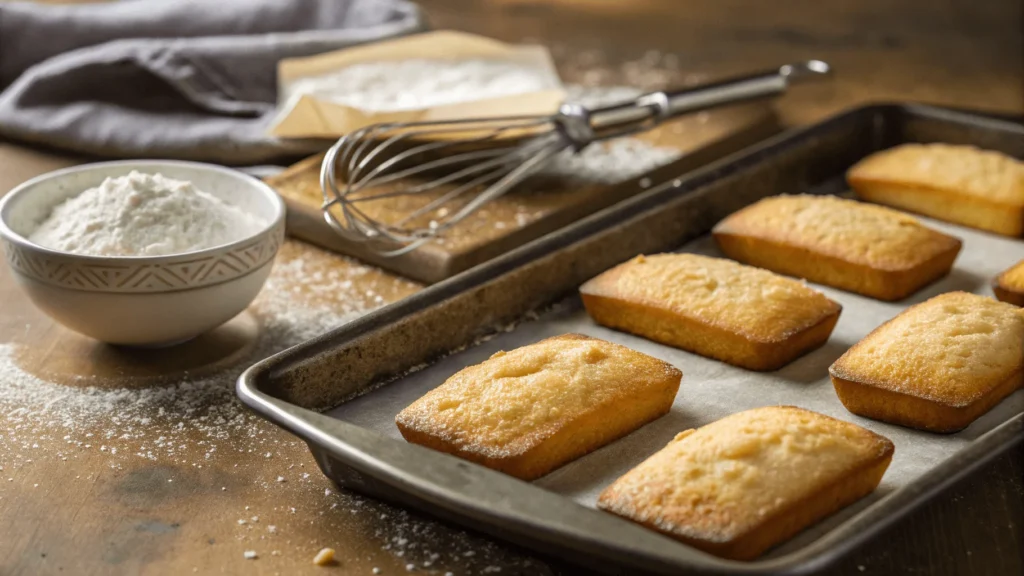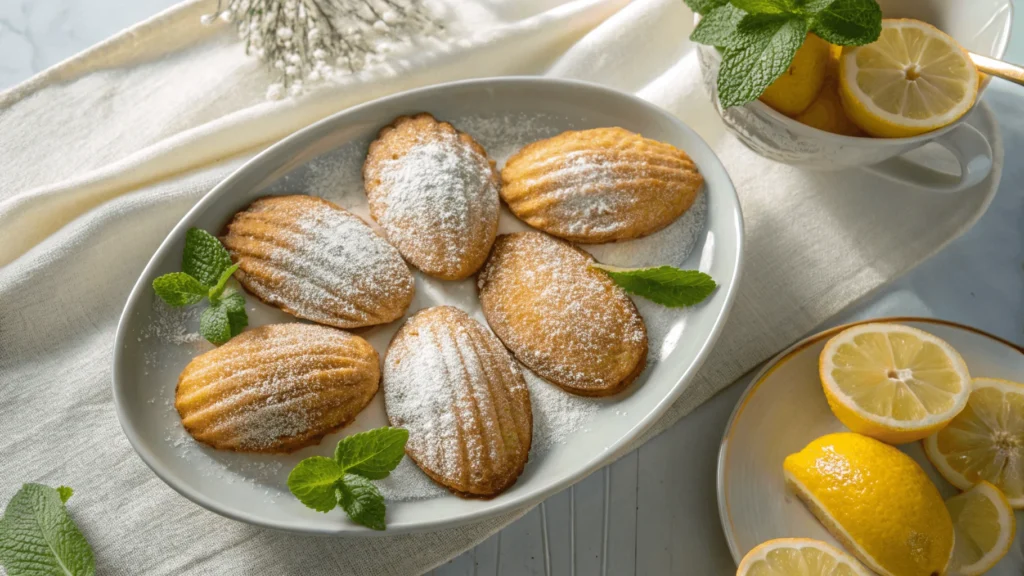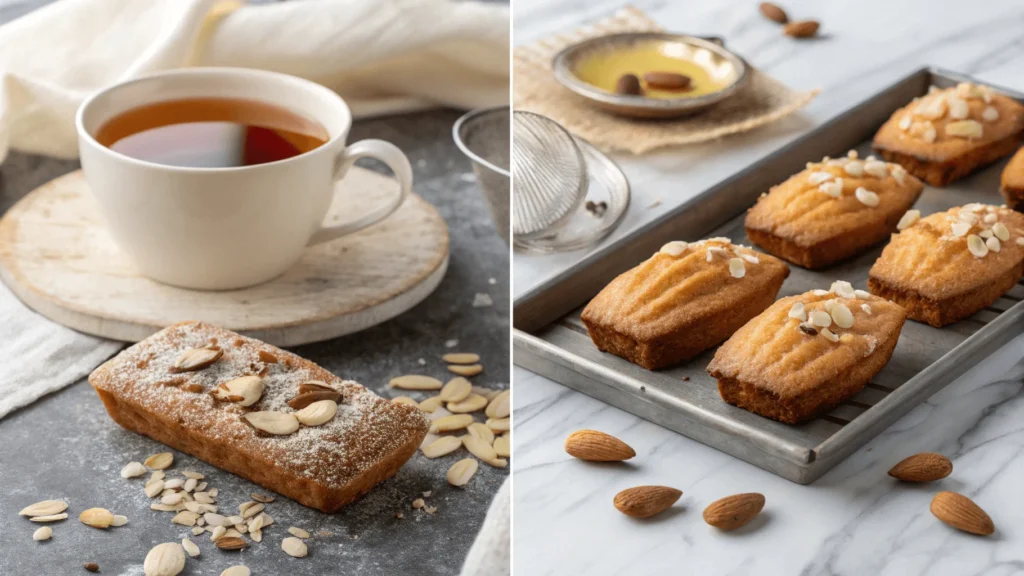When it comes to French pastries, few are as beloved as financiers and madeleines. These two delightful treats have captured the hearts of pastry enthusiasts worldwide. However, despite their similarities, many people still wonder, What is the difference between financiers and madeleines? While both are small, cake-like pastries often served with tea, they have distinct characteristics that set them apart. In this article, we will explore their origins, ingredients, textures, flavors, baking methods, and cultural significance to shed light on what makes each of these pastries unique. Whether you’re a long-time fan of these treats or just beginning to discover them, understanding the difference between financiers and madeleines will deepen your appreciation for these delicious French classics.
Table of Contents
What are Financiers and How Do They Differ from Madeleines?
Financiers are small, rectangular-shaped cakes that are rich and moist in texture, thanks to their unique blend of ingredients. The key feature of a financier is its use of brown butter, which contributes a nutty flavor and a tender crumb. So, what is the difference between financiers and madeleines? The shape and texture are significant distinguishing factors, as financiers are generally denser and heavier, with a strong almond flavor. If you’re curious about other French dessert debates, check out Blondie vs. Brookie Differences.
The Origins of Financiers
The financier pastry originated in Paris in the late 19th century. What is the difference between financiers and madeleines? A pastry chef named Lasne created the treat to resemble gold bars. The name “financier” comes from the French word for “banker,” referencing the pastries’ similarity to the gold ingots traditionally used in financial institutions. The delicate shape and luxurious taste quickly made financiers popular among Parisians, particularly those in the financial district.
Key Ingredients in a Financier
To achieve its signature flavor and texture, financiers require a few essential ingredients. The primary components include:
- Almond flour: This gives the financier its distinct nutty taste and moist crumb.
- Brown butter: Adds a rich, nutty flavor that sets financiers apart from other cakes.
- Egg whites: These help provide structure to the pastry without the heaviness of egg yolks.
- Flour and sugar: Standard cake ingredients, contributing to the overall texture and sweetness.
This combination creates a treat perfect for an elegant tea-time. You might also enjoy learning about Perfect Brookies Recipe as another pastry alternative.
How to Make Financiers: A Step-by-Step Guide
- Preheat your oven to 375°F (190°C) and prepare your financier molds by greasing them lightly.
- Brown the butter in a saucepan over medium heat until it turns golden and emits a nutty fragrance. Allow it to cool.
- Mix the dry ingredients: In a bowl, whisk together almond flour, all-purpose flour, and sugar.
- Incorporate egg whites: Add beaten egg whites into the dry mixture, stirring gently to avoid overworking the batter.
- Combine with browned butter: Pour the cooled brown butter into the batter, mixing until smooth.
- Fill the molds with the batter, ensuring they are about two-thirds full.
- Bake for 12-15 minutes, or until the financiers are golden brown and firm to the touch.
- Cool the financiers before serving to allow the flavors to settle.

What are Madeleines and How Do They Differ from Financiers?
Madeleines are iconic French pastries that are known for their delicate, shell-like shape and light, airy texture. So, what is the difference between financiers and madeleines? Madeleines are typically softer and fluffier than financiers, with a subtle sweetness and flavor. While financiers feature a rich almond profile, madeleines are often flavored with lemon or vanilla, offering a more delicate and citrusy taste. The key distinction between the two lies in their texture and overall taste, with madeleines being lighter and less dense than their financier counterparts.
The History of Madeleines
Madeleines have a long history that traces back to the 18th century in the region of Lorraine, France. The story behind their creation involves a young maid named Madeleine, who is believed to have invented the recipe for a local duke. Over time, the treat became associated with the town of Commercy and gained popularity throughout France. What is the difference between financiers and madeleines? Madeleines have since become one of the most recognizable French pastries, often featured in literature and culture, notably in Marcel Proust’s famous passage from Remembrance of Things Past, where the scent of madeleines triggers a flood of memories.
Essential Ingredients for Madeleines
The ingredients for madeleines are relatively simple, allowing their delicate texture to shine. The basic ingredients include:
- Butter: Adds richness and flavor to the batter, contributing to the pastry’s tender texture.
- Eggs: Provide structure and help achieve the light, airy texture characteristic of madeleines.
- Flour and sugar: Standard baking ingredients that contribute to the cake’s soft, moist crumb.
- Lemon zest or vanilla: These are the most common flavorings, adding a refreshing citrus or aromatic note to the madeleine.
Together, these ingredients create a light, flavorful pastry that has stood the test of time.
How to Make Madeleines: A Step-by-Step Guide
- Preheat the oven to 375°F (190°C) and grease your madeleine pan.
- Melt the butter in a saucepan and let it cool slightly.
- Whisk the eggs and sugar: Beat the eggs and sugar together until the mixture becomes pale and fluffy.
- Add flavorings: Stir in the lemon zest or vanilla extract for an added aromatic touch.
- Fold in the flour: Gradually add the flour to the egg mixture, being careful not to deflate the batter.
- Incorporate melted butter: Gently mix in the cooled butter, ensuring a smooth and consistent batter.
- Fill the molds with batter, making sure to only fill them halfway.
- Bake for 8-10 minutes, or until the edges turn golden and the tops of the madeleines form a dome shape.
- Cool the madeleines on a wire rack before serving.
Comparing the Textures of Financiers and Madeleines: What’s the Difference?
When it comes to texture, the difference between financiers and madeleines is striking. Each pastry has a unique feel that contributes to its appeal.
Moist and Tender Financiers
Financiers are known for their moist and dense texture, largely due to the use of brown butter and almond flour. The richness of the almond flour creates a dense, yet tender, crumb that holds its shape and delivers a satisfying bite. Brown butter also adds a layer of moisture and a distinct nutty flavor that complements the nutty texture. This makes financiers perfect for those who prefer a richer, more filling pastry.
Fluffy and Airy Madeleines
In contrast, madeleines are light and fluffy, with a soft crumb that is much airier than that of a financier. The batter for madeleines is often whipped to incorporate air, which results in a delicate texture that melts in the mouth. The use of butter and eggs in the batter provides a tender structure without the heaviness found in financiers. This makes madeleines ideal for those who enjoy a lighter pastry. For tips on perfecting other delicate desserts, see How to Keep Madeleines Moist.
How Ingredients Influence Texture
The ingredients in both financiers and madeleines play a crucial role in determining their textures. Financiers, with their almond flour and brown butter, tend to be denser and more moist. On the other hand, madeleines rely on whipped eggs and a more straightforward batter, creating a light, airy texture. The differences in fat content, flour, and the presence of almond flour are key factors that contribute to the contrast in texture.
Shape and Appearance: Financiers vs. Madeleines in Form and Design
The shape and appearance of financiers and madeleines are another important distinction.
The Signature Shapes of Financiers
Financiers are most commonly baked in small, rectangular molds, giving them a distinct bar shape. This shape is symbolic of their connection to the financial district in Paris, as it was designed to resemble gold ingots. The rectangular form also allows for a slightly more dense and uniform texture, perfect for the rich, moist interior of a financier.
The Distinct Shell Shape of Madeleines
Madeleines, on the other hand, are typically baked in shell-shaped molds, giving them their signature appearance. This distinctive shape is one of the most recognizable features of madeleines and plays a role in their light, airy texture. The shell shape helps to create a golden, slightly crisp edge while keeping the interior soft and tender.

Flavors: Financiers vs. Madeleines – What’s the Taste Difference?
Both financiers and madeleines offer distinct flavor profiles, shaped by their ingredients and baking techniques.
The Nutty Flavor of Financiers
Financiers have a pronounced nutty flavor, largely due to the almond flour used in the batter. The brown butter also contributes a rich, toasty flavor, enhancing the overall depth of taste. While financiers are often subtly sweet, their nutty and buttery notes make them feel more substantial and satisfying.

The Light and Subtle Flavor of Madeleines
In contrast, madeleines have a much lighter flavor. The most common flavors are lemon or vanilla, giving madeleines a gentle sweetness that does not overpower the delicate texture. The mildness of madeleines makes them perfect for pairing with a cup of tea, as they won’t overwhelm the palate.
Baking Methods and Techniques: Financiers and Madeleines Compared
The techniques used to bake financiers and madeleines contribute significantly to their differences.
The Technique Behind Financier Baking
When baking financiers, it’s important to brown the butter to bring out its rich flavor. The batter for financiers is typically mixed gently to avoid overworking the eggs and flour, maintaining their delicate texture. The baking process also requires a slightly longer time at a higher temperature to achieve a golden, crispy exterior and a moist interior.
The Madeleines Baking Process
Madeleine baking focuses on achieving a light and fluffy texture. The batter must be whipped to incorporate air, which helps the madeleines rise during baking. The use of a madeleine pan with its shell-shaped molds is crucial to their signature form. The baking process is slightly shorter than that of financiers, as the batter requires less time to set.
Serving Suggestions: When to Serve Financiers vs. Madeleines
Both financiers and madeleines are versatile pastries that can be enjoyed in a variety of settings.
Financiers in Tea Time and Dessert Platters
Financiers are perfect for serving at tea time or as part of a dessert platter. Their rich, dense texture makes them a satisfying snack, and their nutty flavor pairs well with a variety of beverages, including coffee or tea.
Madeleines for Tea and Special Occasions
People often associate Madeleines with more formal occasions, including tea parties or special gatherings. Their light and elegant nature makes them ideal for pairing with delicate teas, such as Earl Grey or chamomile.
Both financiers and madeleines have a rich cultural history that reflects the traditions of French pastry-making.
Financiers in French History
Financiers have long been a part of French culinary history, particularly in Paris, where they were first created. Their association with the banking district gives them a unique place in French food culture, as they are often seen as symbols of luxury and refinement.
Madeleines in French Culture
Madeleines hold a deep connection to French culture, symbolizing the country’s commitment to craftsmanship and elegance. As mentioned earlier, their link to literature, particularly through Proust’s Remembrance of Things Past, has elevated them to a symbol of nostalgia and literary tradition.
Financiers come in various regional and flavor variations.
Different Flavors and Additions for Financiers
Many chefs experiment with the basic financier recipe by incorporating additional ingredients such as chocolate, fruit, or different types of nuts. The almond base can be swapped out for pistachios or hazelnuts, giving the pastry a new twist.
Regional Variations of Financiers
Regional variations of financiers also exist, with certain areas of France adding local flavors such as citrus zest, berries, or caramel. These regional differences help give each variation its own unique character.
Exploring Madeleine Variations
Like financiers, madeleines can be made in a variety of creative ways.
Creative Flavors and Filling for Madeleines
Madeleines can be flavored with more than just vanilla or lemon. Some bakers add ingredients like matcha, raspberry, or even chocolate to the batter. Additionally, some madeleines are filled with jam, cream, or chocolate ganache to add an extra layer of flavor.
Regional Twists on the Madeleine
Regional differences also influence the flavor of madeleines. For example, in the region of Lorraine, madeleines may feature a touch of rum, while in other regions, bakers may incorporate regional fruits or spices to give the pastry a unique flair.
Nutritional Differences: Financiers vs. Madeleines – Which is Healthier?
Financiers and madeleines differ not only in taste and texture but also in their nutritional content.
Comparing Calories in Financiers and Madeleines
Generally, financiers are denser and contain more butter and almond flour, making them higher in calories compared to madeleines. Madeleines, being lighter and less rich, are often lower in calories, especially when flavored with only lemon or vanilla.
Healthier Versions of Financiers and Madeleines
Health-conscious bakers can make adjustments to both recipes, such as reducing the amount of sugar or substituting almond flour with healthier options like oat flour. Additionally, using alternative sweeteners can make both pastries suitable for those on a low-sugar or gluten-free diet.
Storage and Shelf Life: How to Store Financiers vs. Madeleines for Freshness
Proper storage ensures that financiers and madeleines maintain their quality over time.
How to Store Financiers for Freshness
Store financiers in an airtight container at room temperature for up to three days. For a longer shelf life, freeze them and thaw when ready to serve.
Storing Madeleines for Optimal Freshness
Madeleines should also be stored in an airtight container. They can stay fresh for up to two days at room temperature. If you want to preserve them for a longer period, freezing madeleines is a good option.
Which One Should You Choose?
Choosing between financiers and madeleines depends on your preference for texture and flavor. If you prefer a rich, nutty, and moist pastry, financiers are the better option. However, if you’re looking for something light, fluffy, and subtly flavored, madeleines will suit your taste.
FAQs
What is the key difference between financiers and madeleines?
The main difference is in texture and flavor. Financiers are denser, moist, and nutty, while madeleines are lighter, airier, and often flavored with lemon or vanilla.
Can I make financiers without almond flour?
Yes, you can substitute almond flour with other nut flours or even all-purpose flour, though this will change the flavor and texture.
Are madeleines difficult to bake?
Madeleines are not particularly difficult to bake, but getting the right texture and shape may take a little practice.
How long do financiers and madeleines stay fresh?
Financiers stay fresh for up to three days at room temperature, while madeleines last up to two days.
Conclusion
In conclusion, while both financiers and madeleines are cherished French pastries, they offer unique experiences based on texture and flavor. What is the difference between financiers and madeleines? The difference lies in their texture, flavor, and appearance, with financiers being dense and nutty and madeleines light and airy. By understanding what is the difference between financiers and madeleines, you can choose the perfect pastry to suit your preferences, whether you’re enjoying a quiet tea time or serving a special occasion dessert.


2 thoughts on “Financiers Vs. Madeleines:The Fascinating Difference You Need To Know”